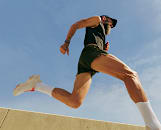
Heel Taps (aka Heel Touches) Torch Your Obliques and Require Zero Equipment
Challenge your core with this accessible and effective move.
By Michele Ross•
What Are Heel Touches?
The Benefits of Doing Heel Touches
What Muscles Do Heel Touches Work?
How to Correctly Do Heel Touches
Heel Touches: Variations and Modifications
Mistakes to Avoid When Doing Heel Touches
How to Add Heel Touches to Your Core Routine
When you think of ab exercises, chances are crunches—whether traditional or bicycle crunches—come to mind. However, it’s important to work all parts of your core not only for strength but also stability, so consider this a friendly reminder that your obliques need some attention, too. One move worth adding to your core workout lineup: oblique heel taps (aka heel touches), which works its namesake muscles and beyond.
Discover more ways to reach your goals with Peloton
Keep reading to discover the ins and outs of heel touches—including how to do them properly and integrate them into your workout routine, according to Peloton instructor Rad Lopez.
What Are Heel Touches?
Heel touches are a bodyweight exercise that help strengthen and stabilize your core. This move involves laying on your back with your knees bent, then tapping your alternate heels by swaying in a side-to-side motion.
Are Heel Touches and Oblique Taps the Same Thing?
This ab exercise goes by a few names—among them heel touches, alternate heel touches, oblique taps, and oblique heel taps. In the Peloton App, instructors refer to this move as oblique heel taps.
Note: Not to confuse you any further, but oblique heel taps and heel taps (aka heel raises or heel lifts) aren’t one and the same. The latter is a classic Pilates move that entails laying on your back, bringing your legs into tabletop position, and slowly lowering one heel to the mat at a time.
The Benefits of Doing Heel Touches
Above all, heel touches are a core exercise. When you strengthen your core, you can anticipate a wide range of benefits. Per a 2023 review in the journal Behavioral Sciences, benefits of core training include:
Stabilizing the spine and trunk while exercising
Improving balance and coordination
Offsetting groin pain
Preventing lower back pain
“A stronger core is going to lead to safer, more efficient, more controlled movements,” Rad explains. Strengthening your core can also improve your posture whether standing or seated, which is a welcome perk to avoid pain (and help reverse the all-too-common modern condition of tech neck).
Moreover, the side-to-side movements of heel touches can help improve spinal flexibility and strength.
Since they primarily work on your obliques (among other abdominal muscles), they also offer an opportunity to make your core workout more well-rounded. Your external oblique muscles are responsible for the likes of:
Rotational movement
Stabilizing your core
Helping pull your chest downwards
Assisting with forced exhales
Assisting with bending from one side to the other
Last but not least, since heel touches are a bodyweight exercise, they don’t require any equipment and are thus highly accessible. All you need is a flat surface (ideally a mat) and commitment.
What Muscles Do Heel Touches Work?
“Heel touches are helpful in targeting the obliques,” says Rad, but they’re not the only muscles that get activated with this move. “They are an excellent way to strengthen the sides of our abdomen, [including] those hard-to-reach intercostal muscles,” which consist of three sets of superimposed muscles located between the ribs.
Aside from being one of the more effective ways to target our obliques, heel touches will also engage your rectus abdominis (top layer of your ab muscles) and the transverse abdominis (aka deep core).
Try Peloton Core Strength Classes

Peloton App
Access thousands of classes with no equipment needed.
How to Correctly Do Heel Touches
Rad cues oblique heel taps as follows:
Start by laying on your back with knees bent and feet firmly planted on the mat. (Your heels should be at least one hand’s length away from your hips.)
Contract your abs as you lift your shoulders off the mat, lift your chin up, and gaze towards the ceiling. Hover your hands 4-5 inches away from your hips and off the mat.
Slowly bend to the right and tap your right heel, contracting your obliques as you move. Repeat the same motion on the left side.
Heel Touches: Variations and Modifications
No matter if you need to pare things back or dial up the intensity, you can always modify heel touches as you see fit.
“If you’re feeling pain in the neck, try lowering your shoulders down to the ground,” Rad advises. (Personally, when my neck feels a bit worse for wear, I’ll cradle the back of my head with one hand and switch off as I alternate sides.) Of course, you can always stick to a lower rep and set count and gradually work your way up.
For those who prefer to level up their oblique heel taps, modify them by:
Holding each tap for an extra second or two
Doing heel touches while holding dumbbells
Moving your heels farther away from your hips to increase the range of motion
P.S. Should you want to *tap* out of oblique heel taps entirely but still target its namesake muscle group, alternatives include:
Oblique crunches
Wood chops
Mistakes to Avoid When Doing Heel Touches
There are a few key mistakes you’ll want to avoid when doing oblique heel taps, not only to maximize your workout but also prevent injury. These include:
Moving too fast. “Oftentimes some people will rush through them and not maintain full control of their torso,” Rad warns. If you rush through this workout, you might also swing with momentum instead of actually (and safely) targeting your abs. Go through the motions slowly, steadily, and with integrity.
Crunching inwards. Heel touches involve lifting your head and shoulders up toward the ceiling rather than rounding your body in a crunched position. As a reminder, Rad advises “raising the upper back off of the ground and mindfully keeping tension within the core.”
Craning your neck. To avoid straining your neck, always focus on lifting from your core instead of your neck. In addition, don’t forget to keep your chin slightly lifted instead of tucked.
Holding your breath. Ab exercises can be notoriously challenging, but even inhales and exhales can help you ride the waves of difficulty and stay the course.
How to Add Heel Touches to Your Core Routine
Heel touches are worth adding to your core routine to give some love, attention, and a burn to your oft-forgotten obliques. For a well-rounded core workout, “Pairing this move with [others] that will target the upper and lower abdominals would be great. I love adding these alongside toe touches (upper abs) and leg raises (lower abs) for a full-frontal core workout,” says Rad.
“Also, don’t forget that the core is built up of a lot more muscles than the abs,” he adds. “Building a routine with an array of exercises that fully work the entirety of our core is key,” Rad continues. “Planks and Super Humans are great to add in to make sure we hit the posterior chain of our core.” Going beyond our “show” abs alone will help prevent lower back pain, he concludes, all the while enhancing the integrity of your workout, the health of your spine, and then some.

Peloton App
Access thousands of classes with no equipment needed.
This content is for informational and educational purposes only and does not constitute individualized advice. It is not intended to replace professional medical evaluation, diagnosis, or treatment. Seek the advice of your physician for questions you may have regarding your health or a medical condition. If you are having a medical emergency, call your physician or 911 immediately.
Level up your inbox.
Subscribe for a weekly dose of fitness, plus the latest promos, launches, and events.
By providing your email address, you agree to receive marketing communications from Peloton.
For more about how we use your information, see our Privacy Policy.








